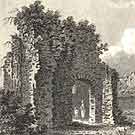Bishop's Palace

Base layers
Data layers

Other Images
Venue Type & Location
Site Name: Bishop`s Palace
Location: Chudleigh
County: Devon
Location Type: Town - in town at determined location
Overview
Located on a slope of the Chudleigh Rocks limestone ridge near the parish church of Chudleigh 10 miles SW of Exeter near the main road to Plymouth. The secluded site, with its panoramic view of wooded hills and limestone moors across the River Teign valley, would have been convenient for bishops travelling from the seat of the diocese at Exeter.
The few ruins remaining in the grounds of Palace Farm provide only the faintest hint of the former splendour of the Exeter bishops' medieval palace. The chief vestiges of the original residence are a vaulted lower-storey building with a ruinous superstructure standing at the W of the site with 3 freestanding fragmentary walls nearby and a perimeter wall along the W side.
Performance History
A possible performance venue. The medieval bishops of Exeter had several residences in Devon. Chudleigh was a favoured palace of Edmund Lacey, who is known to have patronized entertainers in the 15th c. and died there in 1455.
Current Status
Fragments of a vaulted structure, 3 freestanding walls and parts of an enclosure wall remain in the farmyard.
History of the Venue
11th c. Chudleigh formed part of the vast episcopal manor of Bishopsteignton, Devon. A bishop of ca. 1080 selected Chudleigh as a site for one of his rural palaces (Jones, Chudleigh 5).
early 14th c. Borough founded at Chudleigh, probably by Bishop Walter de Stapeldon (1307--26).
1379 Licence to crenellate the episcopal manor granted.
1550 On the order of Edward VI, Bishop John Veysey alienated Chudleigh manor to Thomas Brydges.
1598 Manor conveyed to Thomas Hunt.
1695 Purchased by Hugh Clifford, 2nd Baron Clifford of Chudleigh.
Palace mostly demolished and some of its building stones incorporated for use in the farmhouse and outbuildings at an unknown date.
Record Source
REED Devon 96
Patrons who owned this venue
| Name | Dates | Titles |
|---|---|---|
| Lacey, Edmund | 1370-1455 |
Bibliographic Sources
-
Cherry, Bridget, and Nikolaus Pevsner. Devon. The Buildings of England. London: Penguin Books, 1989.
-
Etched on Devon's Memory. 06/09/2005 (http://www.devon.gov.uk/library/locstudy/etched.html)
-
Hoskins, W.G. Devon. A New Survey of England. Newton Abbot: David & Charles, 1973.
-
Jones, Mary. The History of Chudleigh, Devon: With a Description of the Surrounding Scenery, Seats, Families, etc. William W. Snell, rev. Exeter: Drayton, 1875.
-
Lysons, Daniel and Samuel. Magna Britannia; being a concise topographical account of the several counties of Great Britain. 6 vols. London: T. Cadell and W. Davies, 1806–22.
-
Oliver, George. Ecclesiastical Antiquities of Devon. 3 vols. Exeter: Featherstone, 1840–2.
-
Polwhele, Richard. The History of Devonshire. 1st ed. [1793–1806] printed by Trewman and Son for: Cadell, Johnson and Dilly (vol 1); Cadell, Dilly and Murray (vol 2); Cadell and Davies (vol 3); all in London. 3 vols. Dorking: Kohler & Coombes, 1977.
-
Royal Commission on Historical Monuments England. The Bishops' Palace, Chudleigh, Devon: An Archaeological Survey by the RCHME. Exeter: RCHME, 1999.
-
Thompson, Michael. Medieval Bishops' Houses in England and Wales. Aldershot: Ashgate, 1998.


